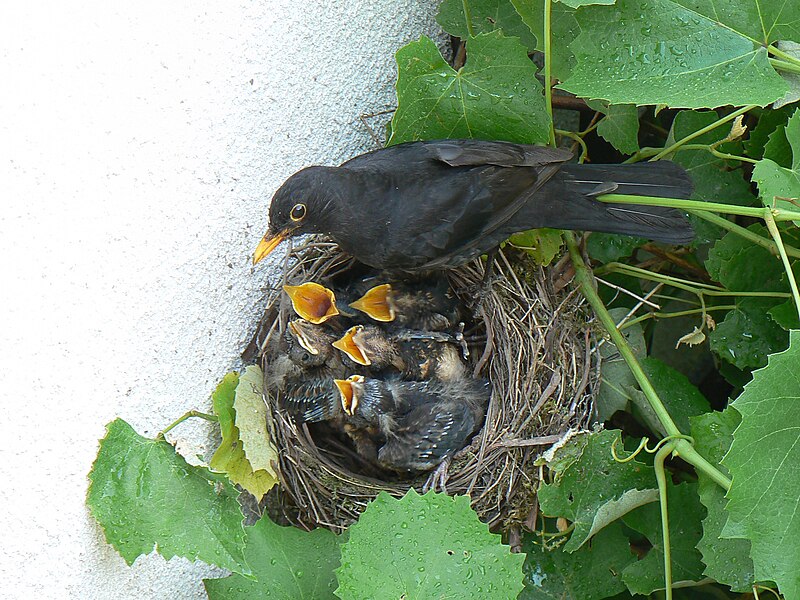Spring is a time of renewal, and for many people that means watching the world around them come back to life. One of the most fascinating parts of nature is seeing how different creatures adapt and thrive in their environments.
Learning about when birds start nesting can help you appreciate the natural world even more. It can also help you be better prepared for what’s to come – whether you’re a bird enthusiast or just someone who wants to enjoy the warmer weather without worrying about poop on your head.
So, When Do Birds Start Nesting?
Different birds nest at different times of the year. But generally, birds start nesting when the weather is warm and they can find enough food to support their young.
In North America, most birds start nesting in the spring. This is because there are more insects around for them to eat, and the trees are starting to bloom.
The earliest ones to nest and lay eggs are usually those that live in warm climates. For example, the American robin starts nesting in late February or early March. The European Robin starts a little later, around mid-March.
Birds that live in colder climates nest later in the spring. For example, the common loon lays its eggs in late May or early June. Some, like the common tern, don’t start nesting until July.
Bird Nesting Cycle
The best way to know if the birds in your area are getting ready to nest is to keep an eye on their behavior. By observing if they are on the stage ready to nest, you can be sure to not disrupt their process.
Each species of bird has its own nesting cycle. Some may only go through the stages one time a year, while others may do it multiple times. Here’s what you should look for to determine if a bird is getting ready to nest:
The Courtship and Pairing Process
This is where birds are getting to know each other and deciding if they want to be together. This usually happens early in the nesting cycle, before they start building a nest.
This is when they come out before winter ends and they will start to mate. The male will start singing to show he is strong and can provide for a family. This is also to warn other males to stay away from their territory and mate with the female.
The female bird will look at different males to see which one she wants to be with. The female will also start to sing, but not as loudly as the male. After they have mated, the birds might start to build a nest together.

The Nesting Process
Once a pair of birds are on their courting stage or have already decided to mate, they will start building a nest. This can take anywhere from a few days to a few weeks, depending on the species and how intricate the nest is.
The female will start gathering materials while the male guards her and keeps other birds away. Nests can be made out of mud, grass, leaves, feathers, and other natural materials. The female bird will do most of the work, but the male might help out a little bit. If you see birds carrying material to a specific spot, they are probably building a nest.
The Mating Process
When the birds have finished building their nest, this is when they mate and lay their eggs. Mating can take days, weeks, or months. The female will lay between one and six eggs, depending on the species. It can also take weeks before all eggs are laid.
The male is also responsible for feeding the female during this time. The male will also stay with the eggs to make sure they don’t get too hot or cold, while the female goes off to find food.

The Incubation Process
Once the eggs are fertilized, the birds will start to incubate them. Incubation is when the birds keep them warm so that they can hatch. This process can take between 11 and 21 days, depending on the species of bird.
After the female bird has laid her eggs, she will start to incubate them. This means she will sit on top of the eggs to keep them warm until they hatch. The male bird will also help to incubate the eggs.
There will be nest robbers who try to take the eggs before they have a chance to hatch. These are animals, such as raccoons or opossums, who will steal the eggs and eat them. But the parents will do their best to protect their chicks from these predators, and if they are successful, the chicks will hatch and fledge.
The Hatching and Nestling Process
The hatching process is a very exciting time for bird watchers! The hatching process can take days. The baby birds will break out of their shell and start to dry off. Once they are dry, they will start to look for food. They will be completely dependent on their parents for food and protection. The parents will continue to feed them until they are able to fly and hunt for food on their own.
The nestling process would continue for weeks until the little ones are ready to try their wings. The parents will continue to feed them and keep them safe until they are able to take care of themselves.
The Fledging Process
The fledging process is when the baby birds learn how to fly and hunt for food. This can take a few days or a few weeks. They will start by hopping around on the ground. Once they are able to fly, they will start to explore their surroundings. The parents will continue to feed them until they are able to find food on their own.
The fledging process is a very important time for hatchlings. They learn how to hunt and survive in the world on their own. It is an exciting time for bird watchers because they get to see the little ones take their first steps in the world.
Factors That Affect Nesting Behaviors
Many factors can affect a bird’s nesting behavior. The bird’s species, location, time of year, weather, and availability of food can all affect how a bird nests. Here are some common factors that can affect nesting behavior:
Life Partner Birds Vs. Promiscuous Birds
There are some species of birds, such as the American goldfinch, who will mate for life. These are called life partner birds. Other species of birds, like the European robin, will mate with multiple partners. These are called promiscuous birds.
Life partner birds tend to have a stronger bond and are more likely to help take care of their young. They have longer courtship rituals and are more monogamous. Their families are also more stable. Promiscuous birds tend to have less of a bond and are less likely to help take care of their young.
Nesting Location
Female birds normally are the one who chooses the nesting location. They will look for a place that is safe and has good cover. They will also look for a place where they can find food for their young.
Birds will choose different places to nest depending on their species. Some birds, like the American goldfinch, will build their nests in trees. Other birds, like the European robin, will build their nests on the ground.
Nest Building
Nesting materials can also vary depending on the bird’s species. Birds like the purple martin will use mud and straw to build their nests. While American goldfinch will use leaves and grass to build their nests.
Unproductive Clutches
Sometimes, a bird will lay an egg but the egg will not hatch. This is called an unproductive clutch. There can be a few reasons for this such as, infertile eggs, may, dead parents, and eggs eaten by predators. When this happens, the bird will usually lay another egg and try again.

Parenting Behaviors
The way that bird parents share their responsibilities can vary depending on their species. For some birds, like the American goldfinch, both parents will take care of the young. While other birds, like the European robin, the female will do all the parenting work.
Some baby birds, like the eaglet, will stay with their parents for a year or more. While others, like the hummingbird, will only stay with their parents for a few weeks.

Nest Robbers
Nest robbers are animals, who will take the eggs or baby birds from a bird’s nest. And this can be very disrupting to birds’ nesting cycle. Some nest robbers will eat the eggs or baby birds. Some will also eat the mother bird. And some will take the eggs to raise as their own.
The most common nest robbers are cuckoos, snakes, and rats. But, any animal that is bigger than a bird can be a nest robber. This includes animals like cats, dogs, and even humans.
Nest Parasites
They are birds, such as the cowbird, who lay their eggs in other birds’ nests. This is called parasitism. The cowbird’s eggs are larger than the other bird’s eggs and they will often push the other eggs out of the nest.
The baby birds that hatch from these eggs will not have any parents to take care of them. They will have to rely on the other birds in the nest to take care of them. This can often lead to the other original hatchlings dying.

The Health of the Egg
Not all eggs are healthy. Some eggs may have a defect that will prevent them from hatching. Some reasons for this is: The embryo is not developing correctly or the embryo has died
Conclusion
So, when do birds start nesting? Nesting season really varies depending on the bird species. But generally, nesting birds lay eggs in the spring or summer. They will build their nests and lay their eggs when the weather is good and there is enough food for their young.
But, sometimes things don’t go as planned and the bird’s nest will be unproductive. And, sometimes animals will disrupt the nesting cycle by taking the eggs or baby birds. But, despite all of these obstacles, these magnificent creatures will continue to nest and birdwatchers will continue to enjoy watching them.
Originally published on https://aaacwildliferemoval.com/blog/birds/when-do-birds-nest/




